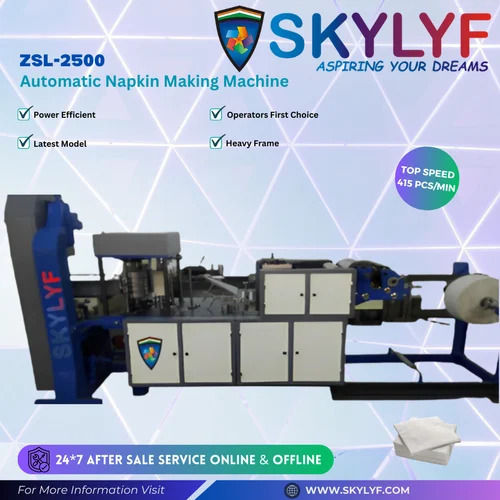Automatic Tissue Paper Making Machine
Product Details:
- Grade Automatic
- Type Paper Embossing Machine
- Material Iron
- Computerized Yes
- Control System PLC Control
- Cutting Speed 25000 sq m/hr
- Cutting Size As per requirnment
- Click to View more
Automatic Tissue Paper Making Machine Price And Quantity
- 350000.0 INR/Unit
- 540000.00 - 1000000.00 INR/Unit
- 1 Piece
Automatic Tissue Paper Making Machine Product Specifications
- As per requirnment
- PLC Control
- 2.5 Watt (w)
- Automatic
- Iron
- 2000 Kilograms (kg)
- Yes
- As per requirnment Meter
- Silver
- 1 year
- 2.5 Watt (w)
- 25000 sq m/hr
- Paper Embossing Machine
- 15*4.0*6 Foot (ft)
Automatic Tissue Paper Making Machine Trade Information
- Cash in Advance (CID), Paypal, Cash Against Delivery (CAD), Cash on Delivery (COD), Cash Advance (CA), Telegraphic Transfer (T/T), Western Union
- 50 Piece Per Month
- 15 Days
- Contact us for information regarding our sample policy
- Asia, Australia, Central America, North America, South America, Eastern Europe, Western Europe, Middle East, Africa
- All India
Product Description
We are manufacturer of Automatic tissue paper making machines which comes with a variety of features aimed at improving efficiency, quality, and sustainability.
-
High-Speed Production: Many machines are designed for high-speed production to meet the demands of large-scale tissue paper manufacturing operations.
-
Modularity: Modular design allows for easy customization and scalability to accommodate different production needs and product specifications.
-
Energy Efficiency: Energy-efficient designs help minimize energy consumption and reduce operational costs. This may include features such as heat recovery systems, optimized drying processes, and efficient motor drives.
-
Advanced Controls: Automated control systems optimize machine performance, regulate process parameters, and ensure consistent product quality. This may involve PLC (Programmable Logic Controller) systems, HMI (Human-Machine Interface) panels, and sensors for real-time monitoring and adjustment.
-
Integrated Stock Preparation: Some machines feature integrated stock preparation systems, streamlining the process by allowing raw materials to be processed directly within the machine.
-
Precision Engineering: Precision-engineered components and assemblies ensure reliable operation, minimal downtime, and long-term durability.
-
Creping Technology: Advanced creping systems enhance the softness, bulk, and absorbency of the tissue paper. This may involve adjustable creping blades, controlled creping pressure, and precision creping geometry.
-
Quality Inspection Systems: Integrated quality inspection systems detect and reject defective products, ensuring consistent quality and minimizing waste. This may include sensors for detecting defects such as tears, holes, or unevenness in the paper.
-
Roll Handling and Packaging: Automated roll handling systems facilitate efficient winding, cutting, and packaging of finished tissue paper rolls. This may include automatic reel changers, slitting units, and packaging machines.
-
Safety Features: Safety interlocks, guards, and emergency stop systems ensure operator safety and compliance with industry standards.
-
Environmental Considerations: Some machines incorporate features for environmental sustainability, such as water recycling systems, emissions control technologies, and use of eco-friendly materials.
-
Remote Monitoring and Diagnostics: Remote monitoring and diagnostics capabilities allow operators to monitor machine performance, troubleshoot issues, and perform maintenance tasks remotely, improving overall efficiency and uptime.

Price:
- 50
- 100
- 200
- 250
- 500
- 1000+



